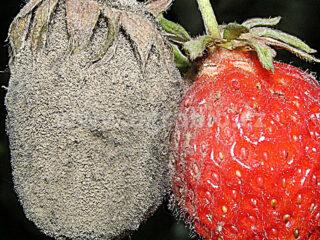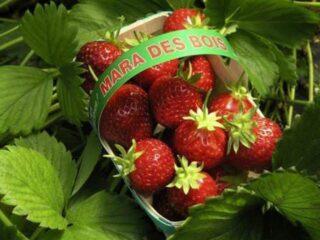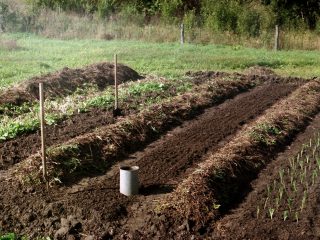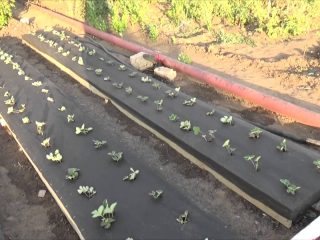Content
At least a small bed of strawberries is an integral part of the vast majority of household plots. There are a lot of varieties of this berry bred by breeders, so gardeners try to choose those that combine outstanding taste with high yields and a relative lack of pickiness in care. The French strawberry Mariguette meets all these criteria.
Breeding history
The strawberry Mariguette, also known as Mariguette and Mariguetta, is from the French company Andre. The creators position the variety as universal, ideal for cultivation in a continental European climate.
Its "parents" were strawberry varieties Gariguette (Gariguetta), well known in France since the beginning of the last century and considered one of the elite varieties of berries, and Mara des bois (Mara de Bois) - an achievement of the breeders of the same company, which appeared in the late 80s ... From the first, Mariguette "inherited" the characteristic shape and size of the berries, from the second - a typical "strawberry" taste and aroma, remontant.
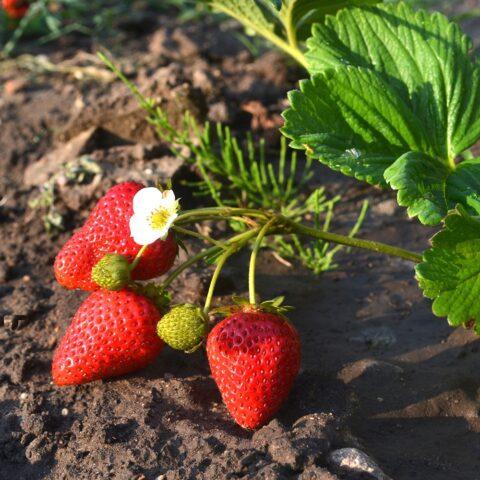
The name Mariguette is a combination of the names of the two varieties that became the "parents" of this strawberry
The name Mariguette is a combination of the names of the two varieties that became the "parents" of this strawberry
At home, this variety went on sale in 2015. In Russia, the Mariget strawberry was certified in 2017. The variety has not yet been included in the State Register.
Description and characteristics of the strawberry variety Mariget
The creators of Mariget are positioned as a strawberry, practically devoid of flaws. The description is, indeed, extremely inspiring for any gardener.
The appearance and taste of berries
Strawberry Marigette looks very presentable. The berries are one-dimensional, relatively large (25-30 g), regular conical or elongated-drop-shaped, with a pointed "nose". The skin is dense, smooth, glossy, pink-red in color.
Fully ripe berries are characterized by a pronounced aroma of wild strawberries. The flesh is pale red, soft and juicy, not too firm. The taste is balanced - very sweet, with a slight refreshing sourness.
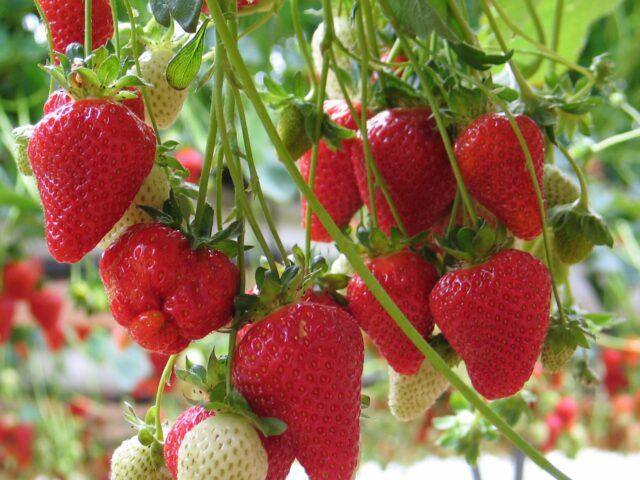
Mariguette berries were recognized by professional tasters as one of the sweetest
Flowering period, ripening period and yield
Mariguette belongs to the early remontant strawberry varieties. It blooms in mid-May. Fruiting begins in early June and ends in early October. In a warm subtropical climate, crops are harvested until frost. For the whole summer, an adult plant brings 0.8-1.2 kg of berries.
The yield of Mariguette strawberry is comparable to Cabrillo. But it loses to the most "productive" varieties, for example, Harmony.
Frost resistance
Cold resistance up to - 20 ºС allows strawberries Mariget to winter without damage to themselves in the subtropical climate of southern Russia, even without shelter. But in the middle lane, she still needs "protection", especially if the winter is predicted to be harsh and little snow.
Disease and pest resistance
According to breeders, strawberry Mariget is practically immune to pathogenic microflora.During the cultivation of "experimental" specimens, there were no cases of infection with real and downy mildew, spots of any kind, root rot and other diseases affecting the root system.
Strawberry Mariget, as practice shows, is also not particularly interesting to pests. Even with massive attacks on neighboring bushes in the garden, they bypass these plants.
Pros and cons of the variety
The advantages of strawberry Mariguette clearly outweigh the disadvantages.
pros | Minuses |
Endurance and ability to adapt to a wide range of climatic and weather conditions | If, at a time when there is a strong heat for a long time and there is no precipitation, regular watering is not ensured, the berries become smaller, "dry out", the taste deteriorates significantly |
High immunity (this applies to both diseases and pests) | The bushes are relatively low (up to 30 cm), but spreading, they need a lot of space in the garden |
Cold hardiness sufficient for cultivation in temperate climates |
|
Ability to tolerate short-term drought without damage |
|
Long-term fruiting |
|
Very good yield |
|
External presentability of fruits (preserved after heat treatment and freezing) |
|
Excellent taste and aroma of berries |
|
The universal purpose of strawberries (it can be eaten fresh, frozen, used for any homemade preparations and baked goods) |
|
Keeping quality (up to five days in optimal conditions) and transportability (thanks to the dense skin) |
|
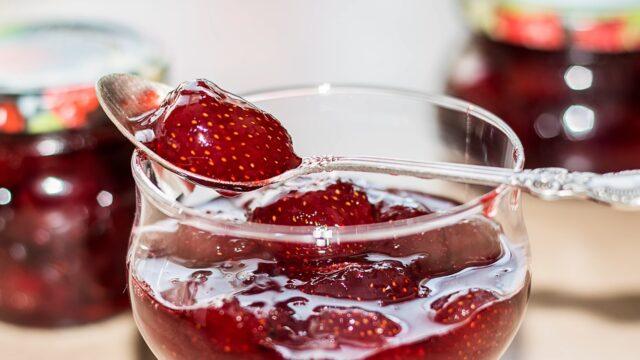
Jams, jams, compotes retain the taste and aroma characteristic of fresh berries, strawberries do not turn into an unappetizing porridge
Growing features
In order for the Marigette strawberry to bear fruit stably and abundantly, it is necessary to take into account important nuances and recommendations regarding its planting and agricultural technology. Moreover, the "requirements" of the variety are few:
- The preferred place for the garden bed is a flat area or the slope of a gentle hill. Lowlands and places where cold humid air stagnates will not work. Like any strawberry, Mariguette does not tolerate northern winds and sharp drafts.
- An ideal substrate is loamy or sandy loamy soils rich in humus. They are light enough, they pass water and air well. Acidity is necessarily neutral (within 5.5-6.0 pH). Although, in principle, Mariget strawberries take root in any soil, except for very heavy clay, swampy, sandy, rocky soils.
- If groundwater approaches the surface closer than 0.5 m, it is necessary to look for another site or build beds with a height of at least 30 cm.
- When planting between neighboring bushes of strawberries, Mariget leaves 40-50 cm.The interval between planting rows is 60-65 cm.
- The standard breeding method is mustache. Two-year-old, abundantly fruiting bushes are chosen as "mother" ones. A maximum of five mustaches with three rosettes on each are left on them. Thus, one plant produces 15 new ones. It is only necessary to remember that it will not be possible to harvest from the "mother" bushes of Mariget strawberries at the same time. All emerging flower stalks and buds are immediately removed.
- Plants need daily watering only immediately after planting, before rooting. The average rate is 2-3 liters of water per 1 m². As soon as new leaves appear, they switch to weekly watering, consuming 5-7 l / m². In extreme heat, the intervals are reduced to 3-4 days, the rate is increased to 2-3 liters per bush.
- Strawberry Marigette prefers specialized store fertilizers. Natural organic matter will not harm it, but it will not provide all the macro- and microelements in the volumes that are necessary for the bushes with such a long fruiting and high yield. Top dressing is applied four times per season - at the moment the first leaves appear, at the budding stage, 4-5 weeks after harvest and immediately after the end of fruiting. The fertilizer used first must contain nitrogen.Further, the strawberry bushes Mariguette require mainly phosphorus and potassium.
- In preparation for the winter, a bed cleared of plant debris is thrown with spruce branches, straw, fallen leaves, having previously sprinkled peat or humus on the bases of the bushes (mounds 10-15 cm high). Additionally, it can be installed over the arc by pulling lutrasil, spunbond, or any other covering material on them.
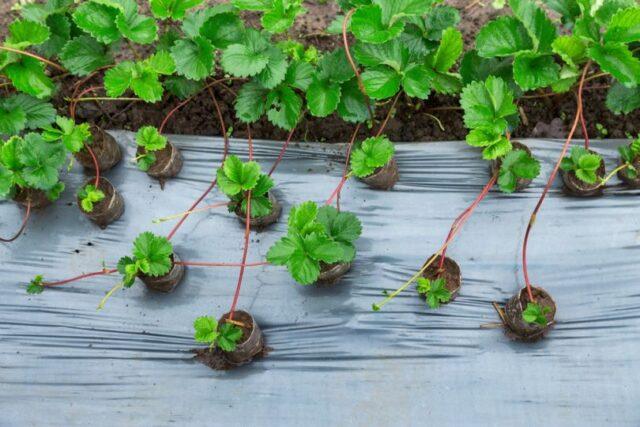
A whisker on the bushes is formed relatively little, but there will be no shortage of planting material
Marigette strawberry planting needs to be updated every 4-5 years. At the same time, it is necessary to move the bed to a new place, taking into account the requirements of crop rotation. Otherwise, not only the quality of the berries suffers - the endurance of plants and their immunity deteriorate.
Conclusion
Strawberry Mariguette is a new French variety specially created for cultivation in the continental European climate. It was bred quite recently, so it is not yet very popular in Russia. However, all the prerequisites for this exist. Mariget stands out against the background of other varieties by a combination of "basic" advantages for a gardener (berry taste, yield, undemandingness). There were no significant shortcomings of the variety.

